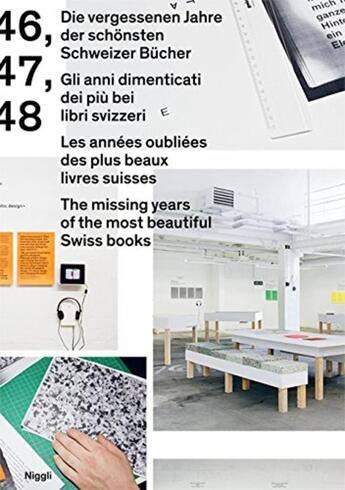-
Date de parution : 01/01/2012
-
Editeur :
Niggli
-
EAN : 9783721208627
-
Série :
(-)
-
Support :
Papier
Résumé:
Since 1943, when Jan Tschichold proposed to honor the most beautiful Swiss books with an annual award, the competition for this title has become very popular and is heard of not only in Switzerland but around the world. A fact that is less well-known is that the title was not awarded between... Voir plus
Since 1943, when Jan Tschichold proposed to honor the most beautiful Swiss books with an annual award, the competition for this title has become very popular and is heard of not only in Switzerland but around the world. A fact that is less well-known is that the title was not awarded between 1946 and 1948 and no books were submitted to it during this time. This gap in the long-standing tradition of the award provided the background for an exhibition, a series of lectures and a research project, that discussed book production and design in Switzerland - with a focus on this specific period, but also with regard to the present situation. Experts such as Jost and Ursula Hochuli, François Rappo, Andreas Schwab as well as many others explain in 14 concise statements their selection of "the most beautiful books" from these years. These authors contributed essays but also texts on their personal interest in and their relationship to books. International authors such as Robin Kinross, Yann Chateigné Tytelman, Severin Rüegg, Philipp Messner, Noah Stolz, Ulrike Meyer Stump and Patrick Gosatti wrote on more specific aspects, starting with the different aspects of book production and design. The book intends to contribute to the discussion among book experts and provides a contemporary commentary on the crucial elements and aspects of book production - now and then.
Seit Jan Tschichold im Jahr 1943 vorschlug, die schonsten Schweizer Bücher auszuzeichnen, erfreut sich der Wettbewerb grosser Beliebtheit und ist international bekannt. Weniger bekannt ist allerdings, dass es in den Jahren 1946, 1947 und 1948 eine Lücke gab: Es wurden keine Bücher eingereicht oder prämiert. Diese Lücke und ihre Zusammenhänge waren Ausgangspunkt für eine Ausstellung, eine Vorlesungsreihe und ein Forschungsprojekt, die das Büchermachen und -gestalten in der Schweiz diskutierten - besonders eben in dieser Zeit, aber auch in Bezug auf die gegenwärtige Situation. In 14 kurzen Äusserungen erklären Fachleute wie Jost und Ursula Hochuli, François Rappo, Andreas Schwab sowie viele andere ihre Auswahl an "schonsten Schweizer Büchern" dieser Jahre. Es entstanden Essays zur Buchgestaltung, aber auch Texte über ihr personliches Interesse und ihre Beziehung zu Büchern. Des Weiteren schreiben internationale Autoren wie Robin Kinross, Yann Chateigné Tytelman, Severin Rüegg, Philipp Messner, Noah Stolz, Ulrike Meyer Stump und Patrick Gosatti über speziellere Themen, angefangen bei den verschiedenen Aspekten der Buchproduktion und -gestaltung. Das Buch soll den fachspezifischen Diskurs weiterbringen und ein zeitgemässer Kommentar dazu sein, was beim Büchermachen damals und heute entscheidend war und ist.
Donner votre avis








